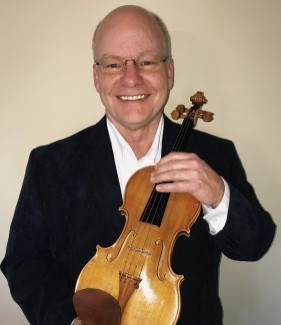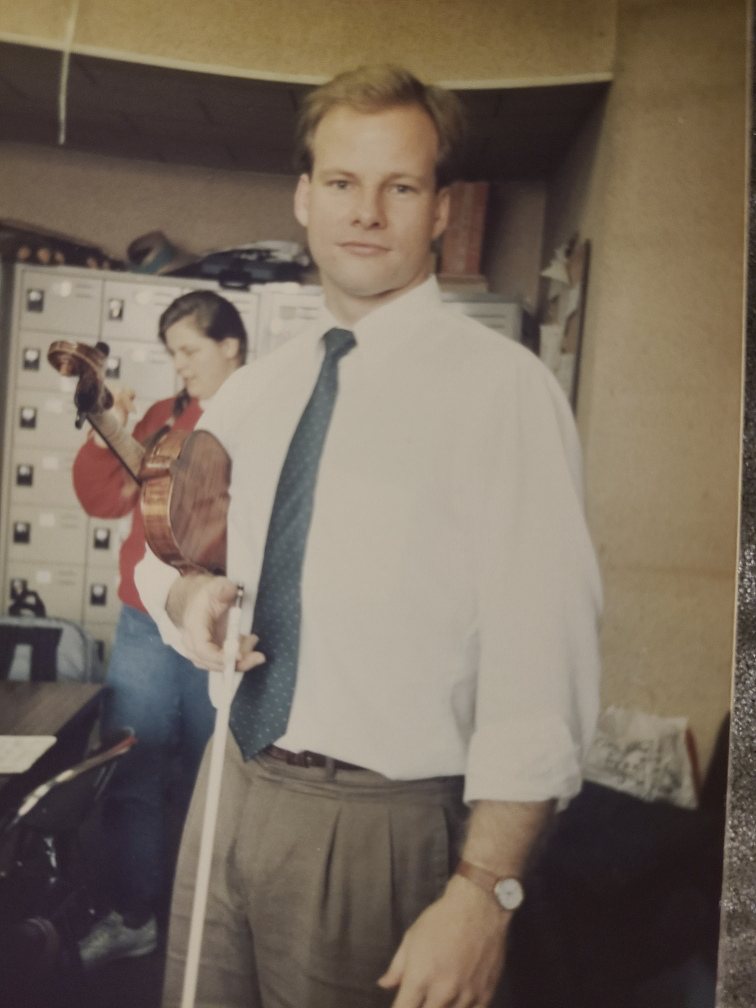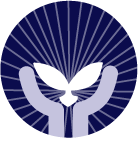Tim Barrett

Tim Barrett is a violinist with a unique teaching enthusiasm of excellence and inspired musicianship that brings smiles to the students and families who study with him. Since moving to Johnson City, TN in 1991 with his wife Kim Barrett, whom he met and married in Japan, he has been the Executive and Artistic Director for a thriving Suzuki program known as the Academy of Strings (AOS). Today AOS has an annual enrollment of over 100 students age three to eighteen that come from seven counties. The program’s growth and development has enjoyed an extraordinarily successful and consecutive 32-year history under the artistic leadership of Tim and Kim which has impacted thousands of students.
Tim Barrett attended the Wanda L. Bass School of Music and Performing Arts at Oklahoma City University where he received bachelor’s and master’s degrees in violin performance and studied with Mr. Lacy McLarry. Tim also completed post graduate work and holds a Teacher-Training Certificate from the Talent Education Research Institute following several years of daily instruction with Dr. Shinichi Suzuki in Matsumoto, Japan.
Professional experiences include being former co-concertmaster of the Johnson City Symphony Orchestra as well as performing in the Pro Musica Chamber Orchestra, Symphony of the Mountains, Asheville and Knoxville Symphonies, Northwood Chamber Orchestra in MI, Sinfonia of Mid-America, and Lawton Philharmonic in OK.
He has received multiple Outstanding Teacher Awards from the Tennessee Governor’s School for the Arts from both former Governor Phil Bredesen and Governor Bill Haslam. As a result of Dr. Suzuki’s personal influence, Tim is an avid lover of lifelong learning and music and has pursued his passion for enrichment and continued learning through the Starling-De-Lay Symposium on Violin Studies at the Juilliard School in NYC as well as many conferences, festivals, and institutes approved by the Suzuki Association of the Americas.
Tim lives in Johnson City with his wife and teaching partner Kim Barrett. They have two adult children, Harrison, and Kristen.
Other places I have lived since Japan: Just Tennessee
Instrument studied in Japan: Violin
Dates in Japan: 1988 to 1991
Memories
When one thinks of the “legacy” of the Suzuki Talent Education movement, we all have benefited and learned from a incredible community of wonderful like-minded musicians and teachers, like many points of light, who were passionately dedicated to the effort and mission of Talent Education. However, when we all think of “legacy” there was no light that shone brighter than Suzuki Sensei (Dr. Suzuki)!
It is very interesting when we hear people who had the opportunity to work with Dr. Suzuki for an extended period of time; how you see them “light up” with this light when they speak of their experiences. His Kan (life force) and influence was experienced by multitudes of teachers and students all across the world. We all have our stories; for me as a boy, adolescent and later a young man in the 1970’s and 1980’s in Oklahoma City, I experienced Dr. Suzuki’s teachings and philosophies through my beloved teacher Mr. Lacy McLarry who introduced me personally to Dr. Suzuki in Chicago at an SAA conference in the mid 1980’s.
Later, after completion of BM and MM degrees in violin performance, in 1988-1991 I count myself so very fortunate and blessed to have had the opportunity to be a member of Dr. Suzuki’s kenkyusei (research student) class in Matsumoto, Japan where I studied with him daily, observed other prominent Japanese teachers, and had a multitude of experiences and interactions for 2 ½ years.
I remember on arriving at the Talent Education Institute (TEI) kaikan (school) and being led upstairs by Dr. Suzuki’s assistant Michiru Hotaka in Matsumoto my first day, expecting to hear a multitude of pieces in the Suzuki repertoire. I was surprised to be hearing other students practicing Mendelssohn, Wieniawski, Bruch, Saint-Saëns, Vieuxtemps, Paganini, Tchaikovsky, Sibelius concerti as well as unaccompanied Bach all at the same time. I recall thinking at the time wondering “What am I getting myself into?” When I got to the top of the stairs, to meet and observe Dr. Suzuki teaching, I met this cute young lady named Kim (more on her later). After that first day of meeting Dr. Suzuki again in Japan, my journey of playing Handel Chorus to the Sibelius concerto as well as many other pieces began…
In the process of writing this I am flooded with countless memories of my “chance of a lifetime opportunity“ spent in Matsumoto. The many lessons learned that hopefully later turned into skills and abilities to share with others in the future from Dr. Suzuki were very numerous. A few that come to mind are: Tone Production – The whole bow arm down to the tips of the fingers moves in a blended motion like a champion baseball pitcher throws the ball. Elbow plays the violin – How we move equals how we sound – Swim deep with the whole arm like a tuna swims deep for depth in tone and color of sound. This was “tuna tone” — you never wanted to have “pencil tone”.
Of course, all who have worked with Dr. Suzuki have the fondest memories of him walking into a room announcing, “I have a new idea!” This brings a smile to my face remembering how many times we heard this and loved hearing this in our time with him. All of us would work diligently over a period of time on the “new idea” to develop and nurture it from a knowledge to an internalized skill and ability to the point we didn’t need to think about it anymore… then it was off to another “new idea“ in the daily kenkyusei group classes with Dr. Suzuki 7 days a week. One of those “new ideas” was two tone vibrato so you didn’t play with a “vibel.” He would give us 1, 2 or 3 Pocky chocolate sticks based on the quality of our vibrato when we each demonstrated the “new idea.” Many tone and technique pedagogical points were brought up with these “new ideas” over the years. Everything from start of tone, upbow staccato, finger motion, portato, bariolage, spiccato and sautillé to tone having living soul among many others were covered always in a fun and engaging manner that was 100% Suzuki Sensei! ☺
Also, no recollections from the kenkyusei class would be complete without mentioning the many hours joyfully spent in “Monday Concert” where all students performed a piece or movement from memory for Dr. Suzuki and all the members of the school. This of course took a couple of hours if not three each Monday afternoon week after week, month after month, year after year. Thank you, Dr. Suzuki, for investing the time into us because it was this experience over time that was transformational. This time of all of us performing on a stage is where we grew and supported each other the most!
Another memory is of Dr. Suzuki grabbing you from one of the two kenkyusei rooms countless times to have an extra lesson with him in his studio. Also, I enjoyed studying all the pedagogical teaching points of all the pieces and repertoire found in the ten Suzuki violin books with Yuko Mori, who taught in the TEI annex building just a block away. I am forever thankful with a debt of gratitude as I enjoyed and learned so much by observing many hours of Mori-sensei, Hasegawa- sensei, Hirose-sensei, and many others teaching over the all too short 2 ½ years.
In addition to the many memories of Dr. Suzuki at TEI, one of my favorite classes was a “Listening” class with Aoki Sensei who had access to an incredible collection of vintage recordings from the entire RCA Victor catalogue. I loved the many hours spent listening to these analog recordings of many of the best historically acclaimed masters and artists. It was like stepping back in time hearing each musician’s unique style of playing.
Another favorite class was “Shuji Class” where we learned how to write Japanese calligraphy in the form of a 20-character Haiku or poem from a Shuji Calligraphy Master. Over time this no doubt changed my bow hand sensitivity and finger motion as a side benefit to learning a wonderful component of the Japanese culture. Towards the end of my time leading up to my graduation, I remember the Shuji Master Instructor carving something meticulously by hand at the end of a 4-inch stick of marble that was roughly an inch square in thickness. I never knew what he had worked on so hard for a couple of months during class until after my graduation recital when he came to my reception and presented me with my own formal authentic Japanese signature stamp which was the beautifully hand carved piece of marble. I was extremely thankful and humbled!
A few memories and behind the scenes stories that occurred outside of class include an instance that happened on a very cold, dreary, rainy, gray winter day in February. Dr. Suzuki and I were seated together on a couch in the lobby of the school at the end of a day. We were enjoying some casual conversation while waiting for the office staff to bring the car around to take him home. At one point, I looked up at the sky through the large glass windows and said sarcastically, “It’s a beautiful day, isn’t it!” Dr. Suzuki then looked up and out the window. He paused and I saw his eyes looking around at the dreary, gray sky and the surrounding area taking it all in for about 15 seconds. He then said “Yes, it is a very beautiful day!” I could see in his eyes that unlike my sarcastic remark, his statement was 100% honest and he meant it. This taught me an extremely valuable lesson that I will never forget.
Another instance after the daily 9am kenkyusei group lesson with Dr. Suzuki, I walked to use the restroom but didn’t notice that he had walked into the restroom before me. When I opened the door, I saw him reaching for his wallet in his suit coat. He told an elderly lady who was bent over cleaning the men’s room fixtures, “I so much appreciate what you do and what you do is very important work. Thank you very much for your service!” He then gave her 30,000 to 40,000 yen. I couldn’t see exactly because I was trying to quietly sneak back out the door without being noticed. Wow! That taught me a huge lesson. He truly did respect the life force in everyone!
Studying in Matsumoto for an extended period of time gave me so many opportunities to experience many wonderful events and glimpses into the very heart of the Talent Education Institute as well as the many rich and meaningful experiences of the Japanese culture. This was everything from the Suzuki Tour Group in final rehearsals before their departure to playing in a chamber orchestra made up of TEI alumni and some kenkyusei who accompanied a concert of 101 grand pianos playing in a large arena to visiting the Kawai Piano factory in Hamamatsu with Kataoka-sensei and some of her piano kenkusei students. She was helping a teacher pick out a piano. There were 10 baby grand pianos in a row on each side of a large showroom. Kataoka- sensei would go down the row playing on each piano. If she liked the piano, she went on to the next. If she didn’t like the piano, she gently lowered the cover over the keyboard. At the end of this “audition”, 5 of the 20 pianos had the keyboards open and not covered. She told the teacher, “Pick from these five pianos”.
Now back to that cute young lady I met at the top of the stairs that first day I arrived that I mentioned at the beginning. Again, her name was Kim Armstrong, and she was from the Philadelphia area and studied with Linda Fiore. Kim told me she had a boyfriend back home and I told her I would never date another musician in my life! We became fonder of each other as time went on as we assisted, demonstrated, and performed at various Suzuki Japanese Teachers’ Conferences, Summer Schools, International Suzuki Conference in Matsumoto, multiple Tokyo Budokan concerts as well as a few special night kenkyusei recitals. One day Mrs. Suzuki requested to see Kim and I in Dr. Suzuki’s office for coffee/tea after a Sunday group class. She told us that Dr. Suzuki and she had been watching us and they thought we should get married. We all laughed together (I loved hearing Mrs. Suzuki’s laugh) and told her that we were already talking about and planning a future together and were thinking the same thing. The rest is history as the Suzukis and Michiru helped us plan the wedding at the Matsumoto Catholic Church (where we all attended mass together on Sunday mornings), a fun reception as well as a beautiful and romantic honeymoon at the historic wooden Mampei Hotel located in the Japan Alps as a wedding gift from Dr. and Mrs. Suzuki. Our parents were not able to attend so the Suzukis were our honorary parents and Dr. Suzuki gave Kim away to me at our wedding.
This all roughly took place a year before we would leave Matsumoto. We had a car that was graciously loaned to us from one of my English student’s families. Mrs. Suzuki would ask us to drive Dr. Suzuki to school and back to their home when the school office staff was out on holidays. We enjoyed lunch at the Suzuki’s home and Dr. Suzuki’s code name to us became “Dad.” We would say we need to remember to take “Dad” home at the end of his teaching day at school when the office staff was gone.
Pulling this to a close, there are no words that can express my thankfulness, gratitude and appreciation to Dr. and Mrs. Suzuki, Michiru, all the wonderful teachers and our fellow kenkyusei classmates for giving me the most enriching and absolutely incredible 2 ½ years of my life! These are some of the most generous and humble human beings I have ever met.
Kim and I have been teaching side by side and sharing those incredible Talent Education points of light that we learned and internalized for over 30 years now at the Academy of Strings in Johnson City, Tennessee, USA. Nestled in the beautiful Appalachian Mountains we currently teach 105 students ages 3-18 and their families from 9 counties in East Tennessee and Southwest Virginia.
“With the right environment and the right works, every child can!”
Warmest regards and respect,
Tim Barrett
Photos in Matsumoto

Tim in the kenkyusei room

